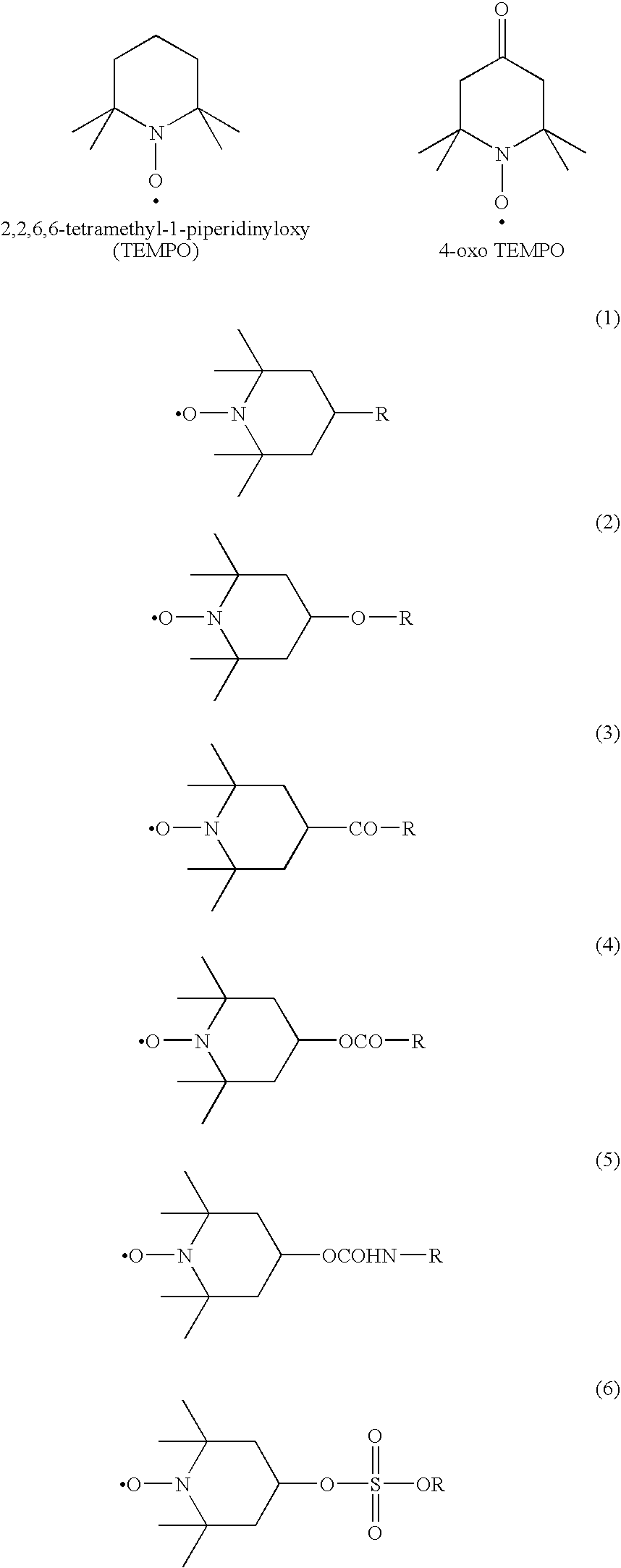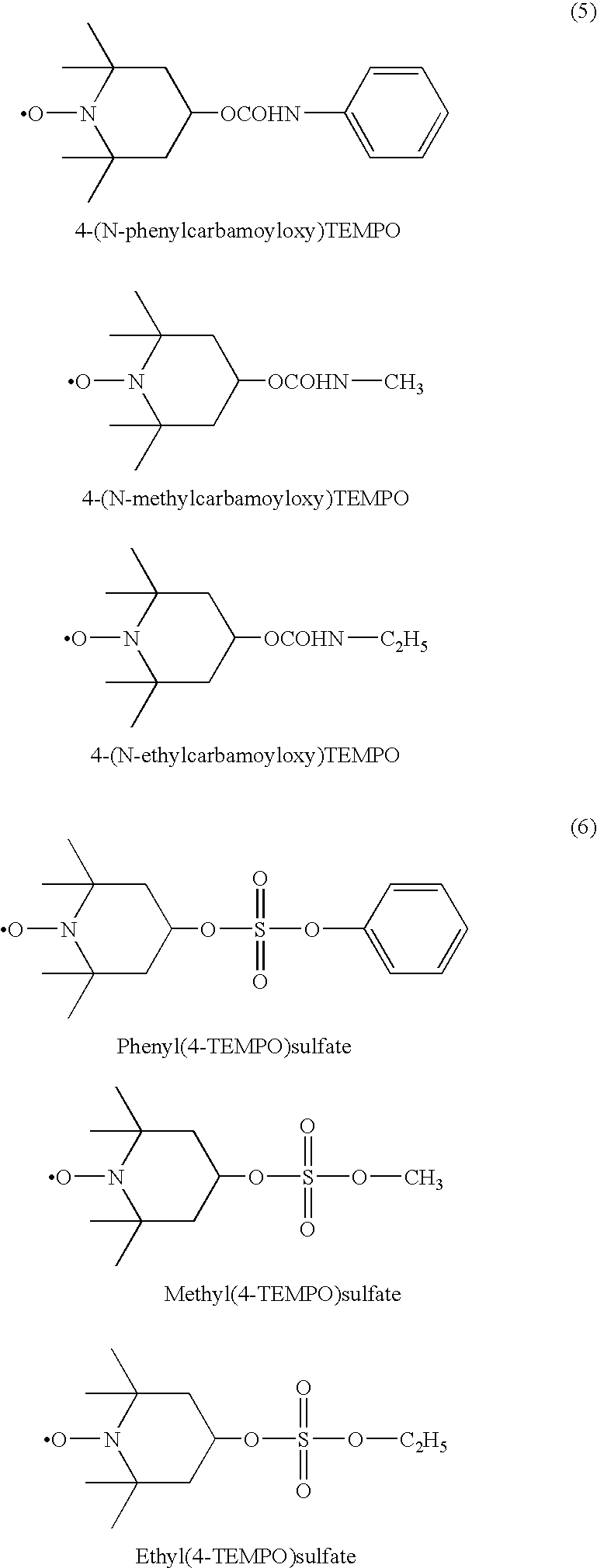Modified diene-based rubber and rubber composition containing the same
a technology of diene-based rubber and rubber composition, which is applied in the direction of special tyres, transportation and packaging, tyre parts, etc., can solve the problems of reducing the strength of rubber materials, difficult to finely disperse in hydrophobic rubber, and important characteristics of tires, so as to improve the dispersibility of silica, improve the abrasion resistance and heat buildup resistance, and reduce the payne effect
- Summary
- Abstract
- Description
- Claims
- Application Information
AI Technical Summary
Benefits of technology
Problems solved by technology
Method used
Image
Examples
production example 1
Production of DHK-2F
[0047]Synthetic polyisoprene rubber (Nipol IR2200 made by Nippon Zeon) in 350 g (5.14 moles), hydroxyl TEMPO(OH TEMPO) (made by NOF Corporation) in 8.86 g (0.0514 mole), and ditertiary butyl peroxide (Perbutyl D made by NOF Corporation) in 0.378 g (in terms of the molecules of decomposition-generated radical: 5.16×10−3 moles, below the number of moles and mol % of the radical initiator all being shown by this way) were mixed in a 600 cc internal mixer set to 60° C. for 5 minutes to cause them to disperse (i.e., premixing). This premixed rubber was mixed in an internal mixer set to 100° C. in a nitrogen atmosphere for 10 minutes and discharged. The temperature at the time of the end of the mixing was 185° C. A part of this rubber was sampled and the hydroxy TEMPO or peroxide residue not bonded with the rubber molecule was removed by dissolving the rubber in toluene, followed by dropwise added into methanol to be coagulated and recovered. This operation was carried...
production example 2
Production of DHK-3F
[0049]The synthetic polyisoprene rubber in 350 g (5.14 moles), the hydroxy TEMPO 8.86 g (0.0514 mole), and the ditertiary butyl peroxide in 0.184 g (2.517×10−3 moles) were mixed in a 600 cc internal mixer set to 60° C. for 5 minutes to be dispersed (premixing). This premixed rubber was mixed in an internal mixer set to 100° C. in a nitrogen atmosphere for 10 minutes and discharged. The temperature at the time of the end of the mixing was 185° C. A part of this rubber was sampled and the hydroxy TEMPO or peroxide residue not bonded with the rubber molecule was removed by dissolving the rubber in toluene, followed by dropwise adding into methanol to be coagulated and recovered. This operation was carried out three times, then 1H-NMR measurement was carried out to calculate the grafted amount of hydroxy TEMPO. The rate of introduction of hydroxyl TEMPO was about 0.3 mol %.
[0050]This modified rubber was weighed to 310 g and mixed together with the methacryloxypropyl ...
production example 3
Production of DHK-4F
[0051]The synthetic polyisoprene rubber in 350 g (5.14 moles), the hydroxy TEMPO in 8.86 g (0.0514 mole) and di(2-tertiary butyl peroxyisopropyl)benzene (Perbutyl P made by NOF Corporation) in 0.213 g (2.517×10−3 moles) were mixed in a 600 cc internal mixer set to 60° C. for 5 minutes to be dispersed (premixing). This premixed rubber was mixed in an internal mixer set to 100° C. in a nitrogen atmosphere for 10 minutes and discharged. The temperature at the time of the end of the mixing was 185° C. A part of this rubber was sampled and the hydroxy TEMPO or peroxide residue not bonded with the rubber molecule was removed by dissolving the rubber in toluene, followed by dropwise added into methanol to be coagulated and recovered. This operation was carried out three times, then 1H-NMR measurement was carried out to calculate the grafted amount of hydroxy TEMPO. The rate of introduction of hydroxyl TEMPO was about 0.3 mol %.
[0052]This modified rubber was weighed to 3...
PUM
| Property | Measurement | Unit |
|---|---|---|
| temperature | aaaaa | aaaaa |
| temperature | aaaaa | aaaaa |
| temperature | aaaaa | aaaaa |
Abstract
Description
Claims
Application Information
 Login to View More
Login to View More - R&D
- Intellectual Property
- Life Sciences
- Materials
- Tech Scout
- Unparalleled Data Quality
- Higher Quality Content
- 60% Fewer Hallucinations
Browse by: Latest US Patents, China's latest patents, Technical Efficacy Thesaurus, Application Domain, Technology Topic, Popular Technical Reports.
© 2025 PatSnap. All rights reserved.Legal|Privacy policy|Modern Slavery Act Transparency Statement|Sitemap|About US| Contact US: help@patsnap.com



